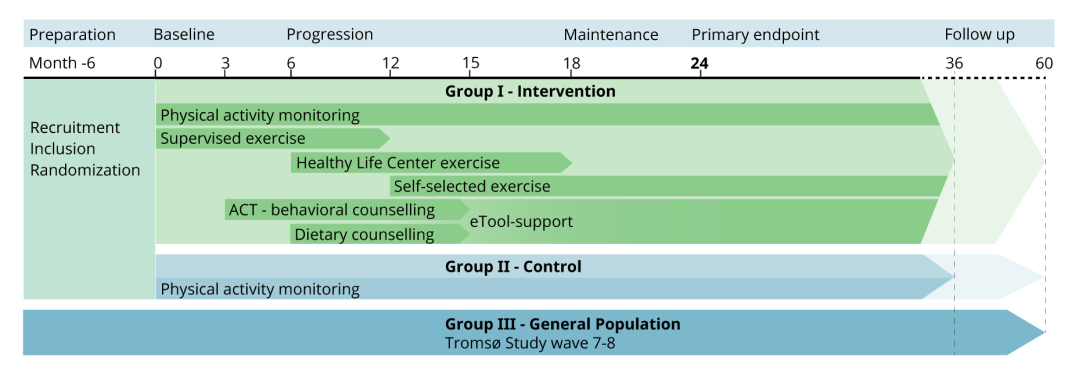In this Q&A, a team from the RESTART project explores their groundbreaking intervention model designed to empower people to embrace healthier lifestyles as they near retirement
The RESTART Project exemplifies the proactive approach public health initiatives can take to address health risks associated with ageing populations; what else can we learn?
Q: How has the Tromsø study inspired the RESTART study? Can you describe it briefly?
The inspiration for RESTART came from the Tromsø Study, an ongoing population study in Tromsø, Norway. The study revealed a concerning trend: a significant rise in overweight and obesity among participants aged 40 and over.
With nearly three-quarters of participants in this age group classified as overweight or obese, researchers with the RESTART project saw a pressing need to take action. We questioned the value of simply observing this trend and opted to explore solutions to help this population live healthier lives.
Q: What is the RESTART model, and what are its components?
The RESTART model tackles the challenges of weight management and lifestyle changes through a three-pronged strategy with a social twist. Participants are divided into groups to enforce a collaborative environment and social support to adopt and sustain a healthy lifestyle:
- Strength and Endurance Training: This core component focuses on improving physical fitness through structured exercise programs. By incorporating both strength and endurance training, the program aims to enhance overall physical well-being.
- Acceptance and Commitment Therapy (ACT): Recognizing the importance of intrinsic motivation, the program incorporates ACT, a form of cognitive behavioral therapy. ACT equips participants with tools to strengthen their internal drive for healthy habits. This empowers them to maintain a healthy lifestyle beyond the confines of the program.
- Dietary Counselling: After six months, the program introduces individual and group dietary counselling sessions. The sesessions go beyond simply providing information; they incorporate practical cooking components.

Q: How is the RESTART intervention study progressing?
To evaluate the effectiveness of the RESTART model, the researchers are currently conducting an intervention study. Participants were recruited from the Tromsø Study and divided into intervention and control groups. Both groups receive an activity tracker and access to standard national advice on diet and physical activity. The intervention group additionally receives the full RESTART program. This approach allows researchers to isolate the impact of the RESTART program on participant outcomes.
We are about four months into the trial and have observed improvements in endurance and strength among the intervention group participants. Additionally, there have been few adverse events so far, which is encouraging.
Q: What are the study endpoints and why were they chosen?
The primary endpoint of the RESTART study is aerobic capacity or endurance. This was chosen because aerobic capacity is a very strong risk factor for cardiovascular disease, making it a crucial measure of overall cardiovascular health.
The secondary endpoints include:
- Muscle Strength: Important for overall physical function and quality of life.
- Waist Circumference: A key indicator of abdominal obesity, which is closely linked to metabolic health risks.
- Body Composition: Includes measurements of body fat and lean muscle mass, providing a comprehensive understanding of participants’ physical health beyond just weight.
These endpoints were selected to provide a broad picture of the health benefits that could result from the intervention, including both cardiovascular and metabolic health improvements. Tertiary endpoints also include quality of life.
Q: What is the mSpider system for monitoring physical activity?
The study utilizes consumer-based smart watches or sports watches to continuously monitor physical activity in participants. The mSpider system is a data collection tool that automatically retrieves activity data from these devices, eliminating the need for manual data collection and download. This system allows researchers to collect objective, long-term data on participants’ physical activity patterns.
Q: How can the mSpider system be used for research purposes?
The mSpider system helps in several ways:
- Monitoring Activity Levels: It allows us to track whether participants become more active and maintain this behavior change over two years.
- Training Feedback: During training sessions, the system ensures participants are exercising within the correct heart rate zones, providing immediate feedback and ensuring they follow the prescribed training patterns.
- Adherence Analysis: By comparing the prescribed heart rate zones with actual performance, we can study the relationship between adherence to exercise instructions and long-term behavior change.
Q: Is there anything else you would like to add about the RESTART study?
The RESTART study plans to collect additional data beyond physical activity monitoring.
- eTool: We develop an eTool to support participants’ habit change and enforce the intervention components.
- Long-term Evaluation: We will measure the primary endpoints after two years, which includes 18 months of intervention followed by a period where participants are encouraged to engage in local NGO activities.
- Interview and Economic Analysis: We will conduct interviews to explore participant experiences and motivation throughout the trial. Additionally, a health economic evaluation will be performed to assess the cost-effectiveness of scaling up the intervention for municipal primary healthcare.
Visit our website:
https://en.uit.no/project/restart_eng

This work is licensed under Creative Commons Attribution-NonCommercial-NoDerivatives 4.0 International.


